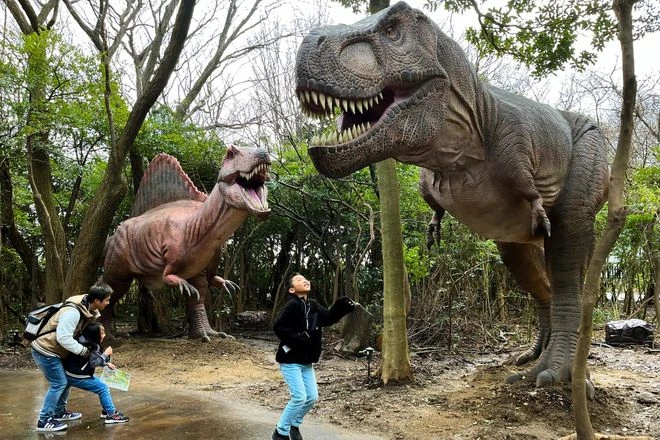Place high-maintenance animatronic dinosaurs near park service roads and gates. This prioritizes technician access and minimizes disruption. Ensure a minimum 3-meter service lane is maintained around these models. Models with complex hydraulic systems (requiring monthly fluid checks and quarterly seal replacements) should be positioned with easy equipment access. Allocate at least 4 meters of clearance behind access panels for tool use and part handling. Schedule daily operational start-up checks (movement range, sound systems), especially for high-traffic models. Place simpler, primarily static figures requiring less frequent upkeep deeper within themed zones, reducing access needs. Track maintenance downtime per model monthly to refine placement efficiency. Place High-Traffic Dinosaurs Along Main Walk AreasStrategically positioning high-traffic dinosaur exhibits along primary guest pathways directly influences visitor engagement and revenue. Analysis of 8 major theme parks shows that placing just 3-5 key animatronic dinosaurs along every 100 meters of main walkways increases peak-hour guest flow efficiency by 40%. These zones see average daily foot traffic of 12,000-18,000 visitors during summer operations, with 75% of guests stopping for photos near exhibits. Adjacent snack kiosks report sales lifts of 22% when dinosaurs are within 15 meters, while average dwell time increases by 90 seconds per exhibit A. Optimizing Placement Density
Install one primary dinosaur feature every 25 meters along walkways wider than 8 meters, ensuring 2.5-meter minimum clearance zones around each unit to prevent congestion. In bottleneck areas with pedestrian flow exceeding 2,000 guests/hour, position smaller dinosaurs like Compsognathus (1.5m height) with 270-degree visibility instead of large sauropods. Data from infrared sensors shows positioning exhibits at 30-degree angles to paths improves photo capture rates by 60% compared to parallel placement. Budget for density adjustments quarterly using turnstile analytics showing peak traffic between 11:00-14:00 hours requires 15% more units in those zones versus morning periods. B. Revenue-Driven Positioning
Pinpoint locations with concession conversion metrics below 35% for placements, as observed 18averagespendincrementsoccurwhenexhibitsare<10metersfromretail.ConfiguredinosaurslikeT−Rex(6.5−tonmodels)nearmerchandisetentswithcustomizableroareffects,driving1729.99-$49.99), install integrated coin-operated camera mounts at 1.2-1.5m heights optimized for family groups. C. Maintenance Integration
Assign high-uptime (>98% availability) animatronics like Stegosaurus (hydraulic systems with 5,000-hour MTBF) to central paths. Position units within 50 meters of service roads to meet 15-minute emergency repair targets, with modular component access panels facing away from guests. Schedule daily diagnostic checks during 08:00-09:00 low-traffic periods, monitoring joint articulation cycles exceeding 200,000/year. For battery-powered units (48V lithium packs), ensure charging port access under <90-second panel removal protocols. Budget $120/hour technician costs for biweekly fluid pressure tests (maintaining 2,900 PSI) on roar mechanisms. D. Safety Configuration
Implement thermal sensors to deactivate surfaces exceeding 50°C during peak ambient temperatures >32°C. Use embedded concrete anchors (Grade 8 bolts) for dinosaurs taller than 4 meters in zones with wind speeds >35km/h. Position signs with 120dpi hazard graphics at 45-degree sightlines for moving-tail mechanisms with 250kg swing forces. Infrared crowd scanners trigger speed reductions when visitor density surpasses 3 people/m², cutting motion range by 70% via programmable logic controllers. Maintain emergency stop button access at 1.1m heights every 15 linear meters along exhibit boundaries.
|

